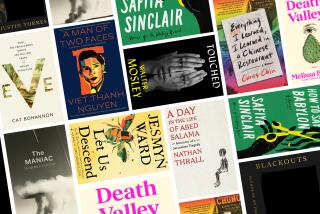Filling in pieces of a family puzzle
- Share via
When Michael Holroyd, the British biographer of such well-known literary figures as Lytton Strachey and George Bernard Shaw, turned his extensive research abilities and writing skills loose on his own family, a fascinating volume, “Basil Street Blues” (2000), was born.
Mixing the rigor of a formal biographer with the intimacy of one telling a family story, Holroyd shaped a hybrid form. The book’s tone -- balancing between the distanced, formal analysis of an investigator holding his subject at arm’s length and the close-to-the bone look of a memoirist -- touched a chord in many readers, who in turn let Holroyd know of other pieces of the family puzzle. “Mosaic” is the literary piecing together of those missing bits of information.
The most fascinating stories in “Mosaic” focus on two individuals who were tangential to the original tale, two people who’d wronged the Holroyd family in generations past, and of Holroyd’s journey to find out more about them. There’s Agnes May, the woman who took up with Holroyd’s married grandfather and caused great pain to the family. The grandfather had set up Agnes May as his mistress in a London apartment for a number of years, and in doing so, ultimately ruined his family’s financial security. What happened to Agnes May, Holroyd wonders, after his grandfather resumed his place in his family? How did she fare in the world?
Then there’s Hazlehurst, a “dashing yachtsman and solider” who broke the heart of Holroyd’s Aunt Yolande when she’d been a young women. Although the couple had never been officially engaged, they’d been together for 10 years. As Yolande waited for him to return from World War II and marry her, Hazlehurst had gone on and married a young local woman he’d met while posted in Italy. Yolande’s life was never the same. She lived a mostly solitary existence, and upon her death at age 96, Holroyd sets out to find out who Hazlehurst had been and what exactly had become of him.
“[W]e all had parallel pasts which, to avoid embarrassment or pain, had been brushed and combed into polite fictions,” Holroyd writes of his drive to find the truth behind the family facade. Along the way, he gives readers intriguing glimpses into the work of a biographer on the hunt -- the endless research, the questions left unanswered, the disheartening dead-ends and the adrenaline rush when he hits upon a kernel of truth. He also uncovers fascinating details about the human character, including the tendency for people to compensate for their disappointments in gender-specific ways: Men, he finds, often raise the status and importance of their occupations on passports and marriage certificates, while women lower their ages.
“Mosaic” consists of discrete essays that all tie, in one way or another, to his family and his own tale of maturation. As a whole, though, the essays lack a driving central narrative and often assume a level of interest that readers may not share. For example, in response to one reader’s questions as to his own views on women, Holroyd writes in great detail of his young tumultuous love affair with the passionate writer Philippa Pullar. Yet since he doesn’t imbue the story with great narrative emotion -- much of the tale is told in the biographer’s distanced tone -- readers may have a hard time rallying interest.
Holroyd calls “Mosaic” a “postmodern interactive” work and believes that anyone can follow the narrative without being familiar with the earlier book. That may be true, but the experience of reading “Mosaic” on its own is like being at a party where everyone’s talking about a group of people you’ve never met. Even if their antics are explained to you, they remain ciphers.
Thankfully, an exception can be made for the tales of Agnes May and Hazlehurst. Since Holroyd himself truly “meets” these two for the first time while investigating “Mosaic,” they come to the page with fully imagined lives, dragging in their wake a wonderful sense of intrigue and mystery. As we watch Holroyd dig and delve into their pasts, we come to share his faith that these characters, and the details he uncovers about their lives, may indeed “contribute through their posthumous disclosures to our understanding of the living world.”
More to Read
Sign up for our Book Club newsletter
Get the latest news, events and more from the Los Angeles Times Book Club, and help us get L.A. reading and talking.
You may occasionally receive promotional content from the Los Angeles Times.










